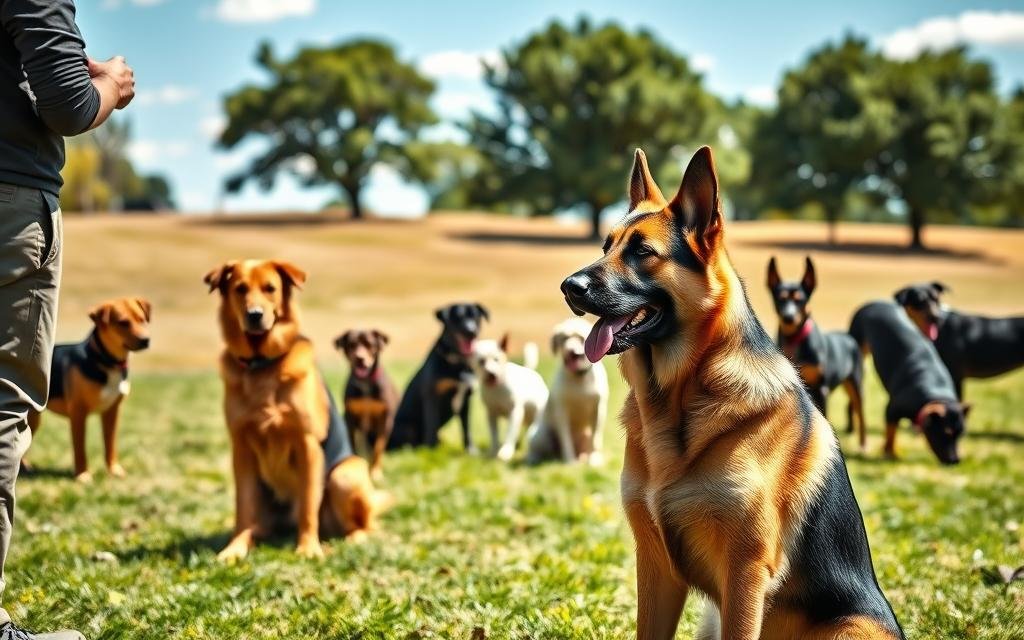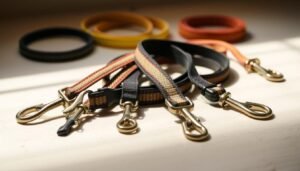Did you know over 80% of dog owners wish their pets were better trained? This fact shows how key dog obedience training is for our pets and us. By training, I teach my dog basic commands and strengthen our bond. This training turns a playful puppy into a well-behaved friend, making our lives better.
In this article, we’ll dive into dog obedience training’s basics. You’ll see the great benefits of spending time and effort on your dog’s training.
Key Takeaways
- The majority of dog owners desire better training for their pets.
- Dog obedience training strengthens the bond between the owner and the dog.
- Basic dog commands make everyday life easier for both the pet and the owner.
- Positive reinforcement dog training creates a positive learning environment.
- Effective training leads to a happier and more well-adjusted pet.
Understanding Dog Obedience Training
Dog obedience training is key to raising a well-behaved pet. It teaches dogs commands and behaviors through different methods. This improves our communication with them. I’ve found that training strengthens our bond and brings happiness to both of us.
What Is Dog Obedience Training?
Dog obedience training teaches dogs essential commands. It helps them understand what we want from them. You can train your dog at home, making it a comfortable place for them to learn.
Benefits of Training Your Dog
Training your dog has many benefits. A well-trained dog has fewer behavioral problems, leading to a happier life. It also makes communication easier, improving our relationship. Training makes your dog disciplined and sociable, enriching their life.
Common Misconceptions
Many think only problem dogs need training. But every dog, no matter their age or personality, benefits from it. Training is about building a strong bond, not just fixing issues.
Key Commands Every Dog Should Know
Teaching my dog basic commands is key for a strong bond and safety. These commands are the foundation of dog obedience. They help us communicate better with our pets.
Sit
The “Sit” command is essential for control. It helps manage my dog’s behavior at home and out. It teaches discipline and respect, stopping unwanted jumping.
Stay
“Stay” keeps my dog in place when needed. It’s useful in busy situations, like waiting at crosswalks. It makes my dog feel secure and comfortable.
Come
The “Come” command is vital for off-leash safety. It lets my dog have freedom without risk. Regular practice makes recall training positive.
Leave It
“Leave It” teaches my dog to ignore distractions. It helps them avoid tempting things and stay focused. This command makes outdoor adventures better.
| Command | Purpose | Benefits |
|---|---|---|
| Sit | Establish control | Foundation for discipline, prevents jumping |
| Stay | Maintain position | Safety in busy situations, promotes calmness |
| Come | Recall command | Essential for off-leash safety, enhances freedom |
| Leave It | Ignore distractions | Prevents impulsive behavior, promotes focus |
Choosing the Right Training Method for Your Dog
Choosing the right training method for my dog means looking at different approaches. Positive reinforcement dog training is very popular. It rewards good behavior to encourage it to happen again. This method helps build trust and creates a positive training atmosphere.
Positive Reinforcement Techniques
In positive reinforcement dog training, rewards like treats or praise are given right after good behavior. This makes my dog more likely to do it again. Using high-value treats keeps my dog excited and focused during training.
Clicker Training Concepts
Clicker training is a special part of positive reinforcement. It uses a small device that makes a sound. When my dog does what I want, I click the device and give a reward. The sound helps my dog know exactly what they did right.
Traditional vs. Modern Approaches
There’s a big difference between old and new training methods. Old methods often use punishment, while new ones reward good behavior. Studies show that rewarding good behavior is kinder and more effective.
| Aspect | Traditional Training | Positive Reinforcement Training |
|---|---|---|
| Training Philosophy | Focus on correction | Focus on reward |
| Dog’s Emotional Response | May cause fear or anxiety | Builds confidence and trust |
| Effectiveness | Short-term results | Long-lasting behavior change |
| Training Atmosphere | Potentially stressful | Positive and engaging |
Essential Tools for Successful Training
Starting leash training with the right tools is key. Essential items like the best leashes, collars, treats, and rewards are vital. They help shape your dog’s behavior positively.
Leashes and Collars
Choosing the right leash and collar is important. Different leashes and collars serve various purposes. For example, a 6-foot leash is great for walks, while a long line leash is better for open areas.
Collars should be comfortable and fit well. Martingale collars help control pulling, and harnesses are safer and distribute pressure evenly. The right gear is essential for successful training.
Treats and Rewards
High-value treats and rewards are vital during training. Dogs love positive reinforcement, and treats they love motivate them. I keep small, tasty treats on hand to keep training exciting.
Using different treats keeps things interesting. My goal is to make learning fun and rewarding. This way, treats and rewards are a big part of training.
Training Clickers
Training clickers are great for clear communication. The clicker’s sound marks the exact moment your dog does what you want. This helps focus training and encourages the right behaviors.
Clickers provide a clear signal, making training more effective. They help in leash training a dog.
Creating a Training Schedule
Creating a consistent training schedule is key for dog training at home. Dogs love routine, and setting specific training times helps them learn better. Regular practice also strengthens our bond.
Consistency Is Key
Consistency in training is very important. Dogs do best when they know what to expect. I always use the same commands and cues.
This repetition helps my dog understand what I want. It also builds their confidence.
Training Duration and Frequency
Training sessions should be short and fun, lasting 5 to 15 minutes a day. This keeps my dog engaged and prevents boredom. Short, frequent sessions work better than long, rare ones.
Regular, brief training makes it a positive experience for both of us.
Incorporating Training into Daily Life
I like to mix training into our daily routines. During walks, I practice commands like “heel” or “sit.” Meal times are great for reinforcing good behavior with commands before eating.
Tackling Behavioral Problems
Managing behavioral issues is key in dog training at home. Dogs may act out for many reasons. Solving these problems can make them happier and strengthen our bond. Here are some effective ways to handle common issues like barking, jumping, and aggression.
Addressing Barking Issues
Excessive barking can be annoying. First, find out what causes it, like boredom or anxiety. Teaching my dog “quiet” or “enough” helps. Also, making sure they get enough exercise and mental stimulation cuts down on barking.
For more tips, check out this resource on solving barking problems.
Managing Jumping and Excitability
Jumping up shows excitement. Greeting my dog calmly helps teach better behavior. When they jump, I ignore them or ask them to “sit.”
This approach helps them learn not to jump up.
Coping with Aggression
Aggression is a big challenge. Finding out why they act aggressively is the first step. It could be fear or defending their territory. Training them to “leave it” and making a safe space helps.
For serious cases, getting help from a pro might be needed. For more advice, see this source on effective strategies.
| Behavior Issue | Possible Causes | Recommended Solution |
|---|---|---|
| Barking | Boredom, anxiety or attention-seeking | Teach “quiet” command; increase exercise |
| Jumping | Excess excitement when greeting | Turn away; reward calm behavior |
| Aggression | Fear, dominance, or territorial issues | Identify triggers; establish training boundaries |
Socializing Your Dog
Socializing your dog is key to their happiness and growth. Meeting new people and animals helps them communicate better. This leads to a more balanced and confident dog.
The Importance of Social Interaction
Social interaction is vital for dogs. A well-socialized dog is less likely to be scared or aggressive. They learn to behave well in public and adapt to different situations.
Safe Environments for Socialization
Dog parks, pet stores, and training classes are great for socializing. I make sure my dog feels safe by watching their body language. This helps them feel confident and ready to meet others.
How to Introduce Your Dog to New People and Animals
Introducing your dog to new faces and animals needs patience. I start in a calm place to reduce stress. Letting them observe first helps them feel more comfortable.
Positive reinforcement, like treats, makes meeting new friends rewarding. This approach boosts dog socialization and strengthens their connections.
Training Sessions: The Do’s and Don’ts
Training sessions are great for both me and my dog. It’s key to keep them fun and engaging. This keeps my dog interested. Positive reinforcement makes learning commands fun.
Keeping It Fun and Engaging
Being excited during training makes my dog want to join in. Adding play to commands makes a big difference. Using toys or praise makes learning fun.
Positive reinforcement rewards good behavior. This lets my dog learn while having fun.
Avoiding Frustration
Frustration can ruin training. It affects my mood and my dog’s willingness to learn. I keep sessions short, around 5 to 10 minutes.
This prevents my dog from getting overwhelmed. I know when to change the pace or end on a high note. Treats or praise celebrate any success.
Building a Stronger Bond Through Training
Every training session makes our bond stronger. Positive engagement builds trust and respect. My dog’s eagerness to learn grows as our bond deepens.
This shows the power of positive reinforcement. Training together strengthens our connection. It turns obedience into a fun activity.
Measuring Training Progress
It’s important to check if dog training at home is working. Keeping records of what my dog learns helps me see how they’re doing. Regular checks show me what’s working and what needs tweaking.
Keeping Track of Commands Learned
Keeping a list of commands my dog learns is helpful. It shows me their progress and what needs more work. I use a chart or checklist to mark their achievements, like:
| Command | Date Learned | Status |
|---|---|---|
| Sit | 05/01/2023 | Mastered |
| Stay | 05/10/2023 | In Progress |
| Come | 05/15/2023 | Mastered |
| Leave It | 05/20/2023 | Needs Work |
Recognizing Signs of Improvement
Small changes in my dog’s behavior are big clues. Signs of success include:
- They respond faster to commands
- They focus better during training
- They seem more excited to learn
Seeing these signs motivates me to keep training. It shows my dog training methods are working.
Adjusting Goals for My Dog
Being flexible with training goals is essential. I check my dog’s progress often and adjust as needed. If they learn a command quickly, I set a new, harder goal. If a command is tough, I break it into smaller steps.
Continuing Education for Dogs and Owners
As a dedicated dog owner, I know our journey doesn’t stop after basic obedience. Advanced training classes can change the game, improving my pup’s skills and our bond. The American Kennel Club offers great programs for dog training at home, with levels that challenge and keep things fun.
To make training fun, I add activities that reinforce what we’ve learned. Games like agility courses or scent detection make training exciting. It turns learning into play, not a chore.
I also use books, online courses, and forums to learn more. These resources help me stay updated and find new training methods. By keeping up with education, my dog and I can keep growing together.





















